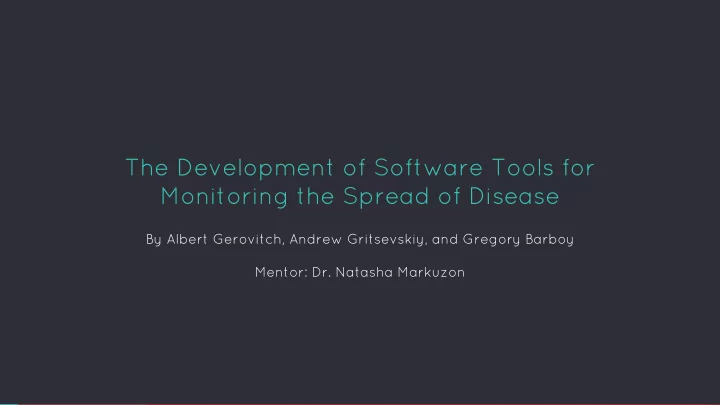

The Development of Software Tools for Monitoring the Spread of Disease By Albert Gerovitch, Andrew Gritsevskiy, and Gregory Barboy Mentor: Dr. Natasha Markuzon ______________________________________________________________________________________________________________________________ ____________________________________________________________________________________________________________________ ___________
Introduction It is of great interest to understand the spread of disease on a local level. However, obtaining localized data and tracking and monitoring spread of disease of individuals is still a big challenge. ______________________________________________________________________________________________________________________________ _______________________________________________________________________________________________________________________ ___________
Goals 1. Enable collection of detailed local data 2. Develop models based on collected and generated data 3. Monitor and predict the spread of a disease on a daily basis 4. Perform analysis on both large and small-scale networks ______________________________________________________________________________________________________________________________ __________________________________________________________________________________________________________________________ ___________
Human Networks ______________________________________________________________________________________________________________________________ _______________________________________________________________________________________________________________________ ___________ ______
Human Networks Three Types of Networks: - Random ß - Small World ß - Scale-Free ______________________________________________________________________________________________________________________________ _____________________________________________________________________________________________________________________________ ___________ ___
Human Networks - Random Network - Random Connections - Algorithm: - Generates a number of connections - Distributes them among people following distribution guidelines for each individual person - Examples: Handshakes at a party ______________________________________________________________________________________________________________________________ _________________________________________________________________________________________________________________________________ ___________ __
Human Networks - Small World Network - Local Connections - Close, nearby on the graph - Range ( k ) of possible friends for each person ( n ) - Person n randomly befriends people (n+k) to (n-k) - Examples: Wikipedia links, Food Chains ______________________________________________________________________________________________________________________________ ________________________________________________________________________________________________________________________________ ___________ ______
Human Networks - Scale-Free Network - Network built by preferential attachment The more connections a node has, - the more likely a new node will connect to it - Defining characteristic: Popular nodes (hubs) - - Examples: The Internet, Semantic Networks ______________________________________________________________________________________________________________________________ ___________
Census Data Integration - Model Network off of town - Number of Households / Residents Per Household - Age Distributions - People of different ages react differently to disease This will be discussed in more detail later ______________________________________________________________________________________________________________________________ ___________________________ ___________
Model Modelling disease spread ______________________________________________________________________________________________________________________________ ______________________________ ___________
Three Components of the Model Three components of our model: 1. Undirected graph (network type) 2. State of each person (S-I-R) 3. Type of interactions between people on the graph ______________________________________________________________________________________________________________________________ _________________________________ ___________
Three Components of the Model ß ß 1. Undirected graph (network type) a. Small-world c. Scale-free b. Random d. Census-based (a, b, c) 2. Type of interactions between people on the graph a. Disease spreads via probabilistic interactions between people ______________________________________________________________________________________________________________________________ ____________________________________ ___________
Three Components of the Model Each person is in one of three states: 1. Susceptible (not yet sick) 2. Infected (sick) 3. Recovered (immune) ______________________________________________________________________________________________________________________________ _______________________________________ ___________
Simulations Simulations and Results ______________________________________________________________________________________________________________________________ __________________________________________ ___________
Our Simulation User can enter a variety of parameters ◦ Structure of network ▫ Type of network ▫ Size of network, etc ◦ Interventions: ▫ Vaccination ◦ Census information ▫ Town or city name Computational duration significantly increases with number of people ______________________________________________________________________________________________________________________________ _____________________________________________ ___________
Automated Parameter Demonstration ______________________________________________________________________________________________________________________________ ________________________________________________ ___________
Automated Parameter Demonstration The program generates a graph On the x-axis, there is the number of initially vaccinated people The red line represents cost The blue line represents length of the epidemic The green line represents total number of people infected during the epidemic ______________________________________________________________________________________________________________________________ ___________________________________________________ ___________
Jung Visualization Demonstration ______________________________________________________________________________________________________________________________ ______________________________________________________ ___________
Different Types of Networks 1. We analyzed simulation results using different types of networks 2. We used the following parameters: ◦ 1000 people 3-7 friends ◦ 10% chance of infecting a friend ◦ ◦ 1 person initially sick ◦ 2 people initially vaccinated A person recovers after 10 days of being sick ◦ If your friend is sick, there is a 10% chance that ◦ you will immediately get a vaccination ______________________________________________________________________________________________________________________________ _________________________________________________________ ___________
Different Types of Networks - Comparison Random Small-world Scale-free ◦ 140 total ◦ 4.6 total ◦ 370 total ◦ 50 days ◦ 25 days ◦ 34 days ______________________________________________________________________________________________________________________________ ____________________________________________________________ ___________
Census-based simulations In order to make our simulations more realistic: ◦ We developed a program to automatically download data from American FactFinder User enters town/city and ▫ state Run simulations on networks ◦ automatically constructed from census data ______________________________________________________________________________________________________________________________ _______________________________________________________________ ___________
Census Based Network Generation Automatically generate a network using our network generation tool along with census data: 1. Household Information a. Number of Households b. People per Household c. All people within Household are connected 2. Age Distribution Data a. Susceptibility and duration of disease change based on age ______________________________________________________________________________________________________________________________ __________________________________________________________________ ___________
Automated Census Simulation Results Simulation without Census data Lexington, MA Total Population: 25 600 Total population: 25 614 10,750 Sick (44%), 44 Days 4,800 Sick (20%), 50 Days ______________________________________________________________________________________________________________________________ _____________________________________________________________________ ___________
Recommend
More recommend